Justice League
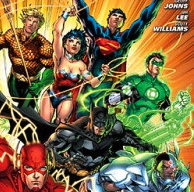
Justice League: A Knight with Shadows
The Justice League, also called the Justice League of America or JLA, is a fictional superhero team that appears in comic books published by DC Comics and Marvel Comics. First appearing in The Brave and the Bold #28 (February/March 1960), the Justice League originally featured Superman, Batman, Wonder Woman, Flash (Barry Allen), Green Lantern (Hal Jordan), Aquaman (Arthur Curry), and the Martian Manhunter. The team roster has been rotated throughout the years with characters such as Green Arrow, Captain Marvel, Black Canary, the Atom,Hawkman, Elongated Man, Red Tornado, Firestorm, Zatanna, Hawkgirl, Cyborg, and dozens of others. The team received its own comic book title in October 1960, when the first issue was published. It would continue to #261 in April 1987, which was the final issue. Throughout the years, various incarnations or subsections of the team have operated as Justice League America, Justice League Europe, Justice League International, Justice League Task Force, Justice League Elite, and Extreme Justice.
Background
Various comic book series featuring the Justice League have remained generally popular with fans since inception and, in most incarnations, its roster includes DC’s most popular characters. The Justice League concept has also been adapted into various other entertainment media, including the classic Saturday morning Super Friends animated series (1973–1986), an unproduced Justice League of America live-action series (for which the pilot film exists), the animated series Justice League (2001–2004) and Justice League Unlimited (2004–2006). A live-action film was in the works in 2008 before being shelved. On June 6, 2012, Warner Bros. announced a new live action Justice League film was in development with Will Beall hired as screenwriter.
Publication history – Silver and Bronze Age / Justice League of America
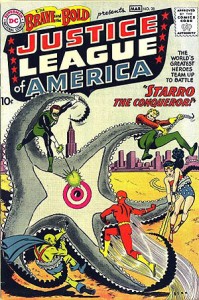 The Brave and the Bold#28: Debut of the Justice League. Art by Mike Sekowsky and Murphy Anderson.
The Brave and the Bold#28: Debut of the Justice League. Art by Mike Sekowsky and Murphy Anderson.
| Justice League of America | |
|---|---|

Cover to Justice League of America #1.
Art by Mike Sekowsky. |
|
| Having successfully reintroduced a number of DC Comics’ (then known as National Periodical Publications) Golden Age superhero characters (Flash, Green Lantern, etc.) during the late 1950s, editor Julius Schwartz asked writer Gardner Fox to reintroduce the Justice Society of America. Schwartz, influenced by the popularity of Major League Baseball’s National League and American League, decided to change the name of the team from Justice Society to Justice League. The Justice League of America debuted in The Brave and the Bold #28 (February–March 1960), and after two further appearances in that title, got their own series which quickly became one of the company’s best-selling titles. Fox and artist Mike Sekowsky were the creative team for the title’s first eight years. Sekowsky’s last issue was #63 (June 1968) and Fox departed with #65 (September 1968). Schwartz was the new title’s editor and oversaw it until 1979. |
The initial Justice League lineup included seven of DC Comics’ superheroes who were regularly published at that time: Superman, Batman, Aquaman, Flash, Green Lantern, Martian Manhunter, and Wonder Woman. Rarely featured in most of the stories, Superman and Batman did not even appear on the cover most of the time. Three of DC’s other surviving or revived characters, Green Arrow, the Atom, and Hawkman were added to the roster over the next four years.
The title’s early success was indirectly responsible for the creation of the Fantastic Four. In his autobiography Stan Lee relates how in 1961, during a round of golf, DC publisher Jack Liebowitz mentioned to Marvel-Timely owner Martin Goodman how well DC’s new book (Justice League) was selling. Later that day Goodman, a publishing trend-follower aware of the JLA’s strong sales, told Lee, his comics editor, to come up with a team of superheroes for Marvel. According to Lee in Origins of Marvel Comics:
| “Martin mentioned that he had noticed one of the titles published by National Comics seemed to be selling better than most. It was a book called The [sic] Justice League of America and it was composed of a team of superheroes. … ‘ If the Justice League is selling ‘, spoke he, “why don’t we put out a comic book that features a team of superheroes?” |
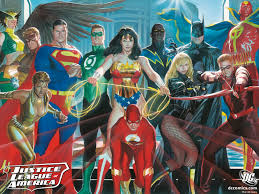 Lee and Jack Kirby produced the Fantastic Four. Other versions of the story suggest that it was Irwin Donenfeld, rather than Liebowitz, who bragged. However, film producer and comics historian Michael Uslan partly debunked the story in a letter published in Alter Ego #43 (December 2004), pp. 43–44:
Lee and Jack Kirby produced the Fantastic Four. Other versions of the story suggest that it was Irwin Donenfeld, rather than Liebowitz, who bragged. However, film producer and comics historian Michael Uslan partly debunked the story in a letter published in Alter Ego #43 (December 2004), pp. 43–44:
| “Irwin said he never played golf with Goodman, so the story is untrue. I heard this story more than a couple of times while sitting in the lunchroom at DC’s 909 Third Avenue and 75 Rockefeller Plaza office as Sol Harrison and [production chief] Jack Adler were schmoozing with some of us … who worked for DC during our college summers…. [T]he way I heard the story from Sol was that Goodman was playing with one of the heads of Independent News, not DC Comics (though DC owned Independent News). … As the distributor of DC Comics, this man certainly knew all the sales figures and was in the best position to tell this tidbit to Goodman. … Of course, Goodman would want to be playing golf with this fellow and be in his good graces. … Sol worked closely with Independent News’ top management over the decades and would have gotten this story straight from the horse’s mouth.” |
Goodman directed his comics editor, Stan Lee, to create a comic-book series about a team of superheroes.
The Justice League operated from a secret cave outside of the small town of Happy Harbor, Rhode Island. A teenager named Lucas “Snapper” Carr tagged along on missions, becoming both the team’s mascot and an official member. Snapper, noted for speaking in beatnik dialect and snapping his fingers, helped the group defeat the giant space starfish Starro the Conqueror in the team’s first appearance.
The supervillain Doctor Light first battled the team in issue #12 (June 1962). Justice League of America #21 and #22 (August–September 1963) saw the first team-up of the Justice League and the Justice Society of America as well as the first use of the term “Crisis” in reference to a crossover between characters. The following year’s team-up with the Justice Society introduced the threat of the Crime Syndicate of America of Earth-Three. The character Metamorpho was offered membership in the Justice League but declined. Following the departures of Gardner Fox and Mike Sekowsky, writer Denny O’Neil and artist Dick Dillin became the new creative team. Dillin would draw the title from issue #64 (August 1968) through #183 (October 1980).
O’Neil reshaped the Justice League’s membership by removing Wonder Woman in issue #69 and the Martian Manhunter in issue #71. Following the JLA-JSA team-up in issues #73-74 and the death of her husband, the Black Canary decided to move to Earth-One to make a fresh start, where she joins the Justice League. The following issue saw the character develop the superpower known as her “canary cry.” In issue #77 (December 1969), Snapper Carr is tricked into betraying the cave headquarters’ secret location to the Joker, resulting in his resignation from the team.
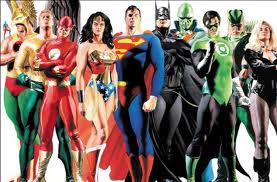 Satellite years – Justice League Satellit.
Satellite years – Justice League Satellit.
In need of a new secure headquarters, the Justice League moved into an orbiting satellite headquarters in Justice League of America#78 (February 1970). The Elongated Man, the Red Tornado, Hawkwoman, Zatanna, and Firestorm joined the team, and Wonder Woman returned during this period. Len Wein wrote issues #100–114, in which he and Dillin re-introduced the Seven Soldiers of Victory in issues #100-102 and the Freedom Fighters in issues #107-108. In the fall of 1972, Wein and writers Gerry Conway and Steve Englehart crafted a metafiction an unofficial crossover spanning titles from both Marvel and DC. Each comic featured Englehart, Conway, and Wein, as well as Wein’s first wife Glynis, interacting with Marvel or DC characters at the Rutland Halloween Parade in Rutland, Vermont.
Beginning in Amazing Adventures #16 (by Englehart with art by Bob Brown and Frank McLaughlin), the story continued in Justice League of America #103 (by Wein, Dillin and Dick Giordano), and concluded in Thor #207 (by Conway and penciler John Buscema). As Englehart explained in 2010, “It certainly seemed like a radical concept and we knew that we had to be subtle (laughs) and each story had to stand on its own, but we really worked it out. It’s really worthwhile to read those stories back to back to back — it didn’t matter to us that one was at DC and two were at Marvel — I think it was us being creative, thinking what would be really cool to do.” Justice League of America #103 also featured the Justice League offering membership to the Phantom Stranger. Len Wein commented on the Phantom Stranger’s relationship with the JLA in a 2012 interview stating that the character “only sort ofjoined. He was offered membership but vanished, as per usual, without actually accepting the offer. Over the years, other writers have just assumed [he] was a member, but in my world, he never really said yes.” Libra, a supervillain created by Wein and Dillin in Justice League of America #111 (May–June 1974), would play a leading role in Grant Morrison‘s Final Crisis storyline in 2008.
Writers Cary Bates and Elliot S. Maggin wrote themselves into the 1975 JLA-JSA crossover in issues #123 and 124 with Bates becoming a supervillain.
Wonder Woman rejoined the team following a major two-year story arc, largely written by Martin Pasko. To prove her worthiness to rejoin the JLA, Wonder Woman voluntarily underwent twelve trials analogous to the labors of Hercules, each of which was monitored in secret by a member of the JLA. After the conclusion of the storyline in Wonder Woman #222, the character’s return to the JLA occurred in a two-part story in Justice League of America #128-129 (March–April 1976).
Steve Englehart wrote the series beginning with issue #139 and provided another unofficial crossover with Marvel Comics in issue #142 by reworking his character Mantis into the DC Universe as a character named “Willow.” Englehart left the title with issue #150. From issue #139 to #157 the issues were giant sized.
Writer Gerry Conway had a lengthy association with the title as well. His first JLA story appeared in issue #125 (December 1975) and he became the series’ regular writer with issue #151 (February 1978). With a few exceptions, Conway would write the team’s adventures until issue #255 (October 1986). Julius Schwartz, who had edited the title since the first issue, left the series with issue #165 (April 1979). The 1979 crossover with the Justice Society in issues #171 and 172 saw the death of the original Mister Terrific. After Dick Dillin’s death, George Pérez, Don Heck, and Rich Buckler would rotate as artist on the title. The double-sized anniversary issue #200 (March 1982) was a “jam” featuring a story written by Conway, a framing sequence drawn by Pérez, and chapters drawn by Pat Broderick, Jim Aparo, Dick Giordano, Gil Kane, Carmine Infantino, Brian Bolland, and Joe Kubert. Bolland’s chapter gave the artist his “first stab at drawing Batman.” Pérez would leave the title with issue #200 to concentrate on The New Teen Titans although he would contribute covers to the JLA through issue #220 (November 1983). The 1982 team-up with the Justice Society in issues #207-209 crossed over with All-Star Squadron #14-15. A Justice League story by Gerry Conway and Rich Buckler originally intended for publication as an issue of All-New Collectors’ Edition saw print in Justice League of America#210-212 (January 1983-March 1983).
Detroit
Seeking to capitalize on the popularity of their other team books, which focused upon heroes in their late teens/early 20s, Gerry Conway and artist Chuck Patton revamped the Justice League series. After most of the original heroes fail to help fend off an invasion of Martians, Aquaman dissolves the League and rewrites its charter to allow only heroes who will devote their full time to the roster. The new team initially consists of Aquaman, Zatanna, Martian Manhunter, Elongated Man, the Vixen, and a trio of teenage heroes Gypsy, Steel, and Vibe. Aquaman leaves the team after a year, due to marital problems, and his role as leader is assumed by the Martian Manhunter.
The final storyline for the original Justice League of America series (#258-261), by writer J. M. DeMatteis and artist Luke McDonnell, concludes with the murders of Vibe and Steel by long-time League nemesis Professor Ivo, and the resignations of Vixen, Gypsy, and the Elongated Man during the events of DC’s Legends miniseries, which sees the team disband.
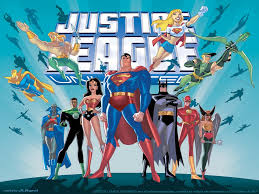 Modern incarnations – Justice League International and Justice League Europe
Modern incarnations – Justice League International and Justice League Europe
The 1986 company-wide crossover “Legends” concluded with the formation of a new Justice League. The new team was dubbed “Justice League” then “Justice League International” (JLI) and was given a mandate with less of an American focus. The new series, written by Keith Giffen and J. M. DeMatteis with art by Kevin Maguire (and later Adam Hughes), added quirky humor to the team’s stories. In this incarnation, the membership consisted partly of heroes from Earths that, prior to their merging in the Crisis on Infinite Earths, were separate. The initial team included Batman, Black Canary, Blue Beetle, Captain Marvel, Doctor Light (a new Japanese female character, emerging from the Crisis of Infinite Earths, not the supervillain who had appeared previously), Doctor Fate, Martian Manhunter, Mister Miracle, and Guy Gardner; and soon after inception, adds Booster Gold, Captain Atom, Fire (then known as the Global Guardians‘ Green Flame), Ice (then known as the Global Guardians’ Icemaiden), and two Rocket Reds (one was a Manhunterspy, and one was Dimitri Pushkin). The Giffen/DeMatteis team worked on Justice League for five years and closed out their run with the “Breakdowns” storyline in 1991 and 1992. The series’ humorous tone and high level of characterization proved very popular.
After Giffen and DeMatteis’ departure. DC created numerous spin-off titles. In 1996, the series was canceled, along with spinoffs Justice League Europe, Extreme Justice, and Justice League Task Force.
| JLA | |
|---|---|
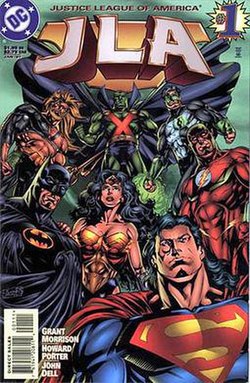
Cover for JLA #1. Art by Howard Porter and John Dell.
|
|
| The low sales of the various Justice League spinoff books prompted DC to revamp the League as a single team (all the various branch teams were disbanded) on a single title. A Justice League of America formed in the September 1996 limited series Justice League: A Midsummer’s Nightmare by Mark Waid and Fabian Nicieza, which reunited the “Original Seven” of the League for the first time since Crisis on Infinite Earths. In 1997, DC Comics launched a new Justice League series titled JLA, written by Grant Morrison with art by Howard Porter and inker John Dell. |
This series, a “back-to-basics” approach, used as its core the team’s original seven members, or their successors: Superman, Batman, Wonder Woman, Aquaman, Flash (Wally West), Green Lantern (Kyle Rayner), and the Martian Manhunter. Additionally, the team received a new headquarters, the “Watchtower“, based on the Moon. JLA quickly became DC’s best-selling title, a position it enjoyed off and on for several years.
Morrison introduced the idea of the JLA allegorically representing a pantheon of gods, with their different powers and personalities, incorporating such characters as Zauriel, Big Barda, Orion, Huntress, Barbara Gordon (Oracle), Steel (John Henry Irons), and Plastic Man. He also had Aztek, Tomorrow Woman, and Green Arrow (Connor Hawke) as temporaries.
Under Morrison, the series pitted the League against a variety of enemies including White Martians, renegade angels, a new incarnation of the Injustice Gang led by Lex Luthor, and the Key. Other foes were the new villain Prometheus, the existing JLA villain Starro the Conqueror, “The Ultra-Marines”, and a futuristic Darkseid. Morrison’s run culminated in an arc titled “World War III” which involves the New Gods preparing the Earth for battle against a creature known as “Maggedon”, a super-sentient weapon of mass destruction.
Morrison departed with issue #41, after which the book saw runs by Mark Waid and Joe Kelly. Subsequent to this, the series switched to a series of rotating writers with issue #91 while Kelly (via JLA #100) was given the mini-series Justice League Elite, which featured Green Arrow, Flash, and several other characters. The new format saw stories by John Byrne, Chuck Austen, and Kurt Busiek. Geoff Johns and Allan Heinberg would take over the book with #115, which saw a multi-part storyline dealing with the aftermath of Identity Crisis, and served as a lead-in to the events of “Infinite Crisis“, as Superboy-Prime destroyed the Watchtower at the end of issue #119. Bob Harras wrote the book’s final storyline (JLA #120-125) as Green Arrow struggled in vain to keep the League afloat.
In 52 Week 24, Firestorm recruits a group to reform the Justice League. It consists of Firehawk, Super-Chief, Bulleteer, and Ambush Bug. They fight a deranged Skeets who takes Super-Chief’s powers, killing him and numerous people who had received powers through Lex Luthor‘s Everyman Project. Afterward, Firestorm breaks up the team. Also in the series, Luthor’s new Infinity, Inc. was informally referred to as a “Justice League” in solicitations and on covers.
Justice League of America (vol. 2)
One year after the events of Infinite Crisis, Superman, Batman, and Wonder Woman reunite in the Batcave to re-form the League in Justice League of America #0, the kick-off for a new series by Brad Meltzer and Ed Benes. The series featured a roster which included Green Lantern (Hal Jordan), Black Canary, Red Arrow (Green Arrow‘s former sidekick), Red Tornado, Vixen, Black Lightning, and Hawkgirl. The first arc of the series focused upon Red Tornado and pitted the team against a new intelligent incarnation of Solomon Grundy and the rebuilt Amazo. The new incarnation of the team has two main headquarters, linked by a transporter. At the first site is The Hall, which in the mainstream DC Universe is a refurnished version of the Justice Society of America and the All-Star Squadron‘s former headquarters located in Washington, D.C.. Black Canary is elected as the first official Chairperson after the fight against Amazo and Solomon Grundy, and led both the Justice League and Justice Society in a complex quest to reunite time-lost members of the pre-Crisis Legion of Super-Heroes, who had been sent back in time to free both Bart Allen and Flash from the other dimensional realm of the Speed Force. Meltzer left the series at the end of issue #12, with one of his subplots (Per Degaton, a pre-nuclear fire mutation version of Despero, and a circa 1948 version of the Ultra-Humanite gathering for an unknown plot) resolved in the pages of Booster Gold.
| Justice League of America (vol. 2) | |
|---|---|

Variant incentive cover for Justice League of America
(vol. 2) #1. Art by Michael Turner. |
|
Dwayne McDuffie took over the writing job with the Justice League Anniversary Special and the main book with issue #13. Due to DC Comics seeking to launch a spin-off Justice League book led by Hal Jordan, the character was removed from the main League series and replaced by John Stewart. Firestorm also joined the roster, with the series entering into a series of tie-in storylines towards Countdown to Final Crisis, with the arrest of a large number of supervillains (gathered by Lex Luthor andDeathstroke to attack the League on the eve of the wedding of Black Canary and Green Arrow) setting up the Salvation Run tie-in miniseries. Also, roster members Red Tornado and Geo-Force were written out. McDuffie’s removed Hal Jordan in favor of Stewart. Jordan was restored to the roster by issue #19 of the series, only to be removed once again by issue #31.
Issue #21 saw the return of Libra and the Human Flame, setting up their appearances in Final Crisis. Later issues would resolve issues involving Vixen’s power level increase and see the integration of the Milestone Comics characters the Shadow Cabinet and Icon, who fought the Justice League over the remains of the villainous Doctor Light. The group suffered greater losses during Final Crisis with the deaths of Martian Manhunter and Batman, as well as the resignations of Superman and Wonder Woman, who could no longer devote themselves full-time to the League due to the events of the New Krypton and Rise of the Olympian storylines in their respective titles. Hal Jordan would resign as well, clearing the way for John Stewart’s return to the team. Black Canary found herself declaring the League no more, though the group would continue with Canary taking a secondary role. Her last act as leader was to assign John Stewart and Firestorm the task of hunting down the Human Flame, for his part in the murder of Martian Manhunter, as seen in the Final Crisis Aftermath: Run! miniseries.
Vixen would take over the team, with Plastic Man rejoining the group. Len Wein wrote a three-part fill-in story for Justice League of America that ran from #35 to #37. McDuffie was fired from the title before he could return, after discussion postings to the DC Comics message board, detailing behind-the-scenes creative decisions on his run, which were republished in the rumor column “Lying In The Gutter.” James Robinson was announced as the new Justice League of America writer.
 Wein’s fill-in run would be published as Justice League: Cry For Justice neared its conclusion, as Vixen and Black Canary’s group (sans John Stewart) would confront Hal Jordan and Green Arrow’s makeshift Justice League group, which had stumbled upon a plot by the villain Prometheus that had resulted in much death and carnage. During the confrontation over Jordan’s group using torture to extract information from the villains being blackmailed into carrying out Prometheus’ plan, both Roy Harper and Supergirl would discover that one of Jordan’s heroes, Captain Marvel Jr., was really Prometheus in disguise. In the ensuing battle, the League would suffer horrible losses: Roy Harper was maimed and his daughter Lian and hundreds of thousands of people in Star City would be killed by a doomsday device a Prometheus had activated. Vixen would have her leg broken and Plastic Man would have his powers permanently scrambled, making him a slowly disintegrating puddle creature. To save other cities from being destroyed like Star City, the League reluctantly allowed Prometheus to go free. Green Arrow (with help from the Shade) would later track down and kill Prometheus.
Wein’s fill-in run would be published as Justice League: Cry For Justice neared its conclusion, as Vixen and Black Canary’s group (sans John Stewart) would confront Hal Jordan and Green Arrow’s makeshift Justice League group, which had stumbled upon a plot by the villain Prometheus that had resulted in much death and carnage. During the confrontation over Jordan’s group using torture to extract information from the villains being blackmailed into carrying out Prometheus’ plan, both Roy Harper and Supergirl would discover that one of Jordan’s heroes, Captain Marvel Jr., was really Prometheus in disguise. In the ensuing battle, the League would suffer horrible losses: Roy Harper was maimed and his daughter Lian and hundreds of thousands of people in Star City would be killed by a doomsday device a Prometheus had activated. Vixen would have her leg broken and Plastic Man would have his powers permanently scrambled, making him a slowly disintegrating puddle creature. To save other cities from being destroyed like Star City, the League reluctantly allowed Prometheus to go free. Green Arrow (with help from the Shade) would later track down and kill Prometheus.
Following the events of “Blackest Night”, Hal Jordan and Donna Troy begin the task of rebuilding the League, with Green Arrow, the Atom, Batman, Mon-El, Donna, Cyborg, Doctor Light, Starfire, Congorilla, and the Guardian.
At the end of issue #43, the majority of the new members leave. Mon-El and the Guardian leave after Mon-El returns to the future, Black Canary returns to the Birds of Prey, Starfire leaves to join the R.E.B.E.L.S., Green Lantern leaves to locate the other Lantern Corps Entities, and Green Arrow is forced to leave due to his fugitive status. James Robinson said this was due to having second thoughts about his decision to use so many characters, and that the team would have a different roster in the coming months. To replace the departed members, Jade and Jesse Quick were added to the team. Cyborg remained with the team in a reduced capacity, and was eventually given his own co-feature storyline for issues #48–50.
DC announced that Saint Walker of the Blue Lantern Corps would be joining the Justice League during a tie-in to the Reign of Doomsday crossover, but the character did not become a full member due to the cancellation of the title.
The series ended with issue #60 (October 2011), the title being one of the numerous DC books cancelled after the “Flashpoint“crossover. The issue saw Batman disbanding the League due to most of the individual members becoming preoccupied with personal commitments.


